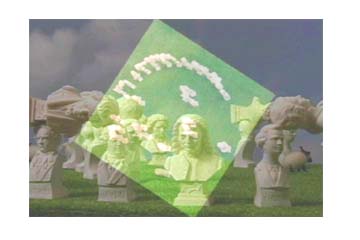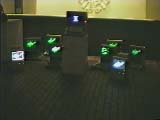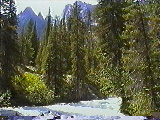s-s-Sound Installations |
|
Tonehenge is something of an expression of my ambivalence about the predominant role that Western classical music continues to play in the experience of many audiences. On one hand, the composers and performers represented on this virtual Salisbury plain include many of my personal heroes, and the compositions that I have sampled for the audio tracks are all works that I have known and loved for most of my life. I’ve studied them, analyzed them, and even learned to play many of them at one time or another. However, it also seems clear to me that the continued popularity of these pieces, along with that of the hundreds of other pieces in the so-called standard repertoire, crowds out more recent works from concert programs and recordings. It is difficult to imagine a concert in the 19th century on which most of the works presented would have been even fifty years old. But now it is fairly unusual to find a concert program on which most of the works, like large old trees in a park, are not at least a hundred years extant. Have those rascal composers from those bygone times in the Old World come now to be not only revered, but the objects of a form of ancestor worship? And has the classical music establishment come to serve as its priesthood? Of course, one of the principal engines of this change has been recording technology. Just as Western popular styles, broadcast and distributed through a relentless series of electronic media and formats over the past century, have endangered indigenous musics around the globe, has the continued prevalence of Western classical music of past centuries, primarily in its recorded forms (“cool media,” as McLuhan described them), become an invasive species in the ecology of music-making in our own time and culture? Are the demands of listeners more easily satisfied by the nurture of relics, and has the craving for novelty and fresh expression been largely extinguished in contemporary audiences? And so, this highly technological piece, Tonehenge, is a tribute, but an ironic one.
Write me (at the email address given at the bottom of this page) if you would like more details, or if you would like to arrange for an installation of the Tonehenge at your institution. The fee for a one-day installation is $600, plus travel expenses. |
|
| Phonemaelstrom
If you have MAX/MSP, version 3.5.9 or later, you can download the patches and soundfiles (20 MB Stuffit archive) and play a portable edition of the Phonemaelstrom on your own Macintosh! (If you don't have MAX/MSP, visit the Cycling74 website for details on how to get it.) Click the image to hear an 86 second audio collage of a phonemaelstrom: mp3 file (1336k) "For further information on Phonemaelstrom, press one." Write me (at the email address given at the bottom of this page) if you would like more details, or if you would like to arrange for an installation of the Phonemaelstrom at your institution. The fee for a one-day installation is $600, plus travel expenses. |
|
| Virtual Windchimes
The Virtual Windchimes consist of a pair of loudspeakers, a Dimension Beam controller (an infrared sensor that generates MIDI messages when it detects movement in its sensitive range), and a Macintosh computer running a MAX/MSP patch that acts as a very simple physical model of acoustic wind chimes. The Dimension Beam controller is the "clapper" of the wind chimes; visitors to the installation can trigger a series of "chime" sounds by interacting with the beam, as indicated by the following performance directions posted near the Beam's sensitive range:
Wave your hand in front of the infrared sensor (the light will briefly turn red when you cross the boundary of the sensor's range). This will provide input to a computer program that acts as a model of windchimes, recreating the seemingly random flurry of sounds from four or more suspended objects. The computer triggers a series of sounds that have been sampled and stored in the computer's memory. Sometimes the sampled sounds will be those of actual chimes. More often, however, you will hear other sounds that have been substituted: The Virtual Windchimes have recently been installed at the Everson Museum in Syracuse, at the Stone Quarry Art Park in Cazenozia, at SUNY Brockport, and at Hamilton College. Alas, Virtual Windchimes is no longer available as an installation, except by special arrangement. Contact me at the email address at the bottom of this page for further details. |
|
It happened!Applritions: Terror in the Orchard!
Many years ago (a dozen or so) there was a peaceable, musical kingdom with many Apples. The Apples, it was believed, would bring knowledge in great abundance to the minstrels of the land, young and old alike. Over the years, newer Apples (Macintoshes and such) were introduced to the land. The older Apples continued to be used, however, until one day they were all carried away to be stored in an evil wizard's workshop. Click on the picture to download a video clip (a 2.6 MB Quicktime movie) of the installation the Seminar in Musical Composition at Hamilton College presented in the Wellin Hall lobby on October 31, 1996. Alas, Applritions: Terror in the Orchard! is no longer available as an installation. |
|
| the Flow
|
|
| For further information about these sound installations, please feel free to contact me! | |




